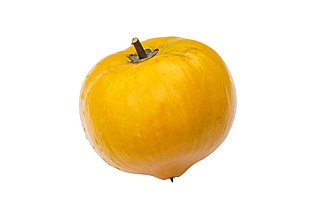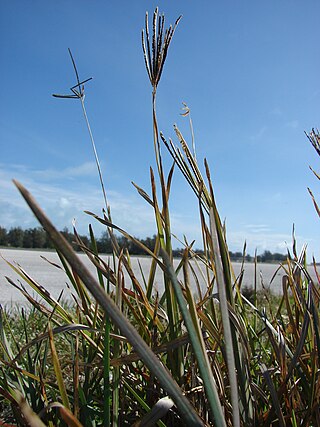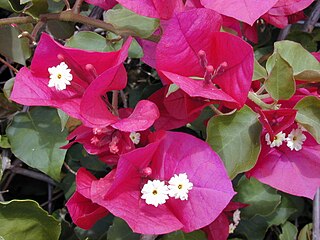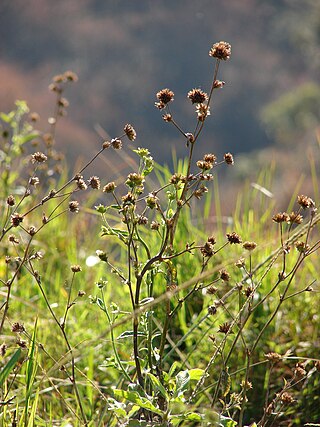
Nothoscordum is a genus of New World plants in the onion tribe within the Amaryllis family. It is probably paraphyletic. The genus is native to North, Central and South America, though a few species have become naturalized in various parts of the Old World.

Psidium is a genus of trees and shrubs in the family Myrtaceae. It is native to warmer parts of the Western Hemisphere. Many of the species bear edible fruits, and for this reason several are cultivated commercially. The most popularly cultivated species is the common guava, Psidium guajava.

Xanthosoma is a genus of flowering plants in the arum family, Araceae. The genus is native to tropical America but widely cultivated and naturalized in other tropical regions. Several are grown for their starchy corms, an important food staple of tropical regions, known variously as malanga, otoy, otoe, cocoyam, tannia, tannier, yautía, macabo, ocumo, macal, taioba, dasheen, quequisque, ʻape and as Singapore taro. Many other species, including especially Xanthosoma roseum, are used as ornamental plants; in popular horticultural literature these species may be known as ‘ape due to resemblance to the true Polynesian ʻape, Alocasia macrorrhizos, or as elephant ear from visual resemblance of the leaf to an elephant's ear. Sometimes the latter name is also applied to members in the closely related genera Caladium, Colocasia (taro), and Alocasia.

Hypochaeris radicata – also known as catsear, flatweed, cat's-ear, hairy cat's ear, or false dandelion – is a perennial, low-lying edible herb often found in lawns. The plant is native to Europe, but has also been introduced to the Americas, Japan, Australia, and New Zealand, where it can be an invasive weed. It is listed as a noxious weed in the northwestern U.S. state of Washington.

Pouteria campechiana is an evergreen tree native to, and cultivated in, southern Mexico, Belize, Guatemala, and El Salvador. It is cultivated in other countries, such as India, Costa Rica, Brazil, the United States, the Dominican Republic, Australia, Cambodia, Vietnam, Indonesia, Sri Lanka, Nigeria, and the Philippines. The edible part of the tree is its fruit, which is colloquially known as an egg fruit.

Caperonia is a genus of plants of the family Euphorbiaceae first described as a genus in 1825. The genus is native to tropical and subtropical America and Africa.

Jabuticaba, also spelled Jaboticaba, is the edible fruit of the jabuticabeira or Brazilian grapetree. The purplish-black, white-pulped fruit grows directly on the trunk of the tree, making it an example of 'cauliflory'. It is eaten raw or used to make jellies, jams, juice or wine. The tree, of the family Myrtaceae, is native to the states of Rio de Janeiro, Minas Gerais, Goiás and São Paulo in Brazil. Related species in the genus Myrciaria, often referred to by the same common names, are native to Brazil, Argentina, Paraguay, Peru and Bolivia.

Cardamine hirsuta, commonly called hairy bittercress, is an annual or biennial species of plant in the family Brassicaceae, and is edible as a salad green. It is common in moist areas around the world.

Sonchus asper, the prickly sow-thistle, rough milk thistle, spiny sowthistle, sharp-fringed sow thistle, or spiny-leaved sow thistle, is a widespread flowering plant in the tribe Cichorieae within the family Asteraceae.

Muntingia is a genus of plants in the family Muntingiaceae, comprising only one species, Muntingia calabura, named in honour of Abraham Munting. It is native from Mexico south to Bolivia and Argentina. Its fruit is edible, and it has been widely introduced in other tropical areas.

Sonchus oleraceus is a species of flowering plant in the tribe Cichorieae of the family Asteraceae, native to Europe and Western Asia. It has many common names including common sowthistle, sow thistle, smooth sow thistle, annual sow thistle, hare's colwort, hare's thistle, milky tassel, milk thistle, and soft thistle.

Cosmos caudatus or king's salad is an annual plant in the genus Cosmos, bearing purple, pink, or white ray florets. It is native to Latin America, and the West Indies, though naturalized in tropical parts of Asia, Africa, and Australia.

Eustachys is a genus of tropical and subtropical plants in the grass family. It is native primarily to warmer parts of the Americas, with a few species in Africa and Asia.

Goeppertia allouia, known as lerén or lairén in Spanish, and also known in English as Guinea arrowroot, and sweet corn root, is a plant in the arrowroot family, native to northern South America and the Caribbean, The name "allouia" is derived from the Carib name for the plant Lerén is a minor food crop in the American tropics, but was one of the earliest plants domesticated by pre-historic Amerindians in South America.
Silvia N. Blumenfeld is an expert on mycology. From 1986 to 2004, she was a Professor of Mycology and Biotechnology of Filamentous Fungi at the National University of Comahue, in Río Negro, Argentina. She emigrated to Israel in 2002, where she became the curator of the Tel Aviv University fungi collection, specializing in medicinal mushrooms. She has over 50 articles, books, and patents to her name, and has received academic honours. In 1995, she was awarded the Argentine National 'José Antonio Balseiro' Prize for her work.

Bougainvillea spectabilis, also known as great bougainvillea, is a species of flowering plant. It is native to Brazil, Bolivia, Peru, and Argentina's Chubut Province. It is widely grown as an ornamental plant.

Yucca aloifolia is the type species for the genus Yucca. Common names include aloe yucca, dagger plant, and Spanish bayonet. It grows in sandy soils, especially on sand dunes along the coast.

Morus celtidifolia, the Texas mulberry, is a plant species native to South America, Central America, Mexico, and the southwestern United States, ranging from Argentina north as far as Arizona and Oklahoma. In the US, it grows in canyons and on slopes, usually near streams, from 200–2,200 metres in elevation. It is very often referred to as "Morus microphylla," including in Flora of North America, but recent studies suggest that these names are synonymous with M. celtidifolia holding priority.

Elephantopus mollis, common names tobacco weed, and soft elephantsfoot, is a tropical species of flowering plant in the family Asteraceae.
Hypochaeris microcephala, the smallhead cat's ear, is a species of plants in the tribe Cichorieae within the family Asteraceae. It is native to South America and naturalized in parts of North America.





















